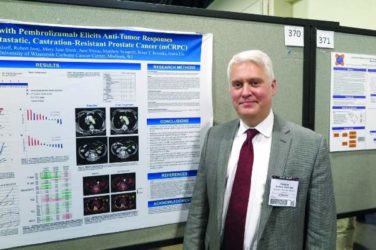AT HIMSS15
CHICAGO (FRONTLINE MEDICAL NEWS) – For Margaret Mary Health in Batesville, Ind., partnerships were central to the formation of its community-wide patient portal.
In 2012, the hospital launched a portal that combines the records and information of multiple health providers in southeast Indiana and surrounding areas into a single system that patients can access. The approach departs from a standard portal model in which each physician practice has its own portal and patients must assess their health information from multiple sources, according to Dr. Jeffrey Hatcher , a Batesville ob.gyn and medical staff liaison for Margaret Mary Health.
“The whole goal of electronic records was to consolidate and centralize and streamline health care records,” Dr. Hatcher said in an interview. “In a lot of ways, what we’re doing is just building on that process. We’ve eliminated the need for all of those individual portals and connected the patients and their physicians to the health information exchange (HIE). Those practices feed the information through the HIE into the patient’s chart.”
Margaret Mary began efforts to design its portal in early 2011. The hospital partnered with NoMoreClipboard , a company that offers patient engagement tools to health providers, and HealthBridge , a nonprofit corporation that supports health information technology adoption and health information exchange (HIE). The timing was perfect, Dr. Hatcher said, because NoMoreClipboard and Indiana Health Information Technology Inc. (IHIT) had just received a joint $1.5 million grant from the Office of the National Coordinator for Health Information Technology (ONC) to develop, deploy, and pilot test solutions that enable patients to access electronic health information exchange data.
Despite a knowledgeable design team, the road to Margaret Mary’s united provider portal was strewn with bumps and obstacles, Dr. Hatcher said at the annual meeting of the Healthcare Information and Management Systems Society (HIMSS). Developers encountered skepticism from some health providers and received push back from electronic health record (EHR) vendors.
The vendors’ “excitement to participate and help us develop this was not as great because it basically took the place of their product,” Dr. Hatcher said in an interview. “It’s a really slow process to get them to cooperate. They’re just not willing to move things along at a pace that’s rapid enough.”
Dr. Hatcher’s team worked to gain the trust of each participant. One key was ensuring that each provider was comfortable with what medical information would be released and when, and what type of sensitive information should be withheld and for how long, he said. Portal developers also had to create policies for the system and take into account the various data access rules of patients’ home states – including Indiana, Ohio, and Kentucky.
There were privacy issues as well. While the hospital serves a regional population of 70,000, it is situated in the rural community of Batesville, a town of 7,000. Residents in the small community historically have passed down identical first and last names for several generations leading to four or five people in the community with the same name, according to a case study on the project by NoMoreClipboard.
To address the situation, development experts created standards-based policies to securely match consumers with their data, and once authenticated, transport those data into patients’ personal health record.
Since the portal launched in 2012, 18,000 patients have accepted their access codes and about 5,000 patient have used the portal, Dr. Hatcher said. Because the portal links to HealthBridge, patients are able to get data from across the continuum of care, whether or not they receive the care at Margaret Mary. HealthBridge serves southwest Ohio, southeast Indiana and northern Kentucky. Additionally, several Cincinnati hospitals have authorized sharing their HIE data with Margaret Mary patients who use the portal.
No hard numbers on the portal’s impact yet exist, but providers have noted an increase in productivity and a rise in patient satisfaction, Dr. Hatcher said.
“When you look at the care perspective, it’s changed the dynamics of the conversations we’re having,” he said. “When patients get data, we can point them to trusted websites and they can come in prepared. The follow-up appointment becomes more of a discussion and not a lab review. Now you’re spending [more] time planning care.”
Dr. Hatcher encourages other physicians and health systems to participate in such patient engagement efforts, especially as Stage 3 of meaningful use approaches. The Centers for Medicare & Medicaid Services has proposed that all physicians and hospitals meet Stage 3 meaningful use requirements beginning in 2018. The proposed rule also calls for 25% of patients to access their data, although it allows for third-party providers to access a patient’s account as a means of satisfying the requirement.
“As we begin this heath care–sharing process, it’s really important to have patients in a position where they’re more educated about the process that’s going on with them,” Dr. Hatcher said in an interview. “The more you educate your patients, the more it helps them embrace what you’re trying to do. It’ll be hard to meet the upcoming meaningful use measures if you don’t have patients engaged in their health care plan.”
Health providers interested in creating a similar patient portal should review what other health systems have done in the past and build on their ideas, Dr. Hatcher added.
“You’ve got to have the enthusiasm of your medical staff,” he said. “You’ve got to have the support of your organization, and you have to have a vision. Know what you want before you start. If you do that, then you’re well on your way.”
On Twitter @legal_med




